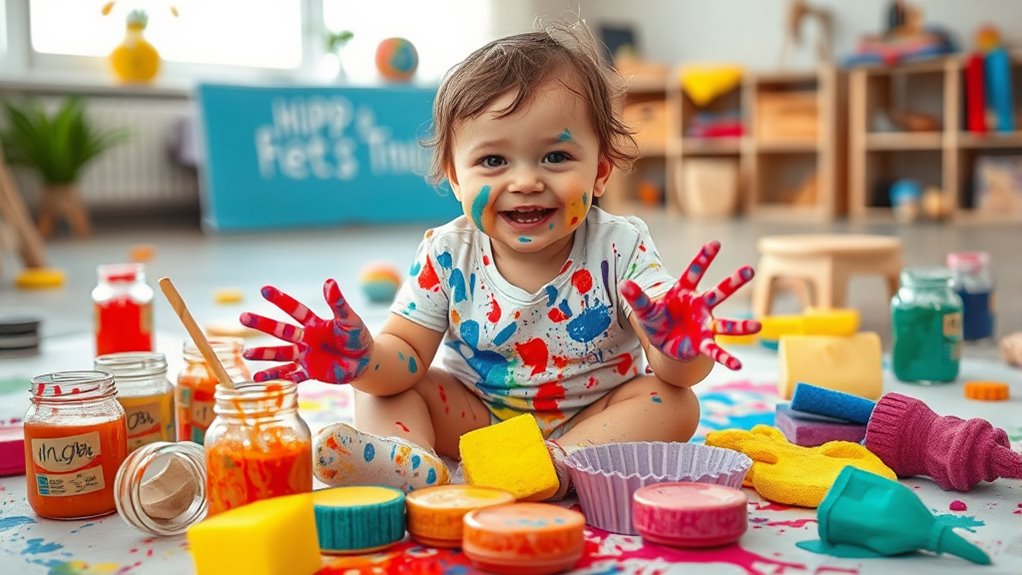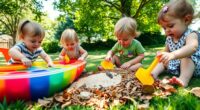Looking for messy play ideas to spark your toddler’s creativity? You can try fun activities like finger painting with bright colors, exploring sensory bins filled with different textures, or making nature collages with leaves and flowers. Water play with toys and tools also encourages fine motor skills and sensory exploration. Don’t forget easy-to-clean options like shaving cream cloud dough or outdoor mud kitchens. Keep exploring these ideas to turn messy moments into imaginative adventures.
Key Takeaways
- Incorporate sensory activities like finger painting, shaving cream cloud dough, and sensory bins to stimulate creativity and motor skills.
- Use outdoor natural materials such as leaves, flowers, and twigs for collage making and eco-friendly play challenges.
- Include water play with toys, funnels, and cups to develop fine motor skills and introduce color mixing concepts.
- Create messy art projects like bubble wrap stomp art and nature collages to encourage artistic expression.
- Ensure activities are supervised, safe, and use non-toxic, reusable materials to promote imaginative play and environmental responsibility.
Finger Painting Adventures
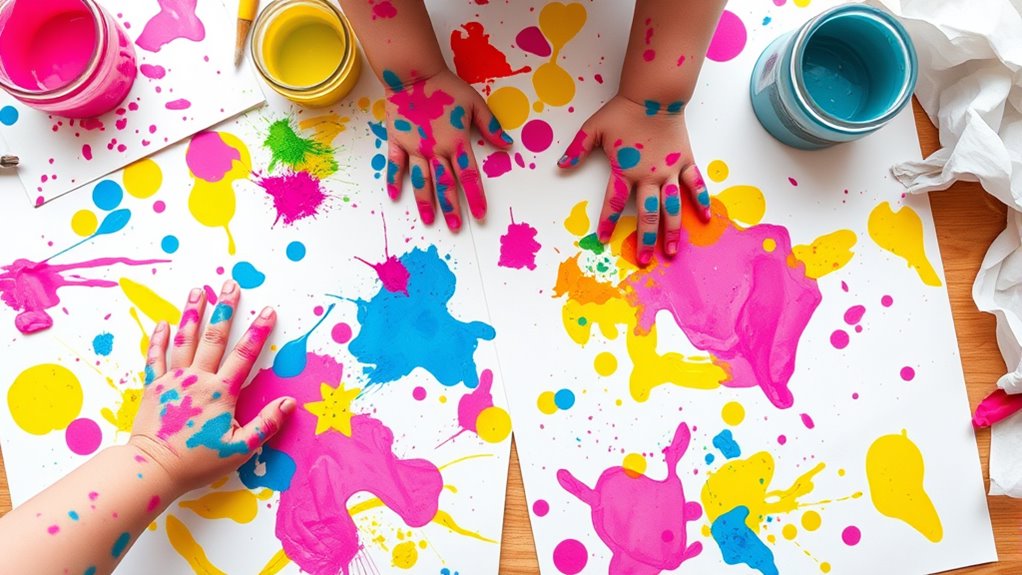
Finger painting adventures are a fun and simple way to introduce your toddler to creative expression. With finger painting, your child gets hands-on experience that nurtures their imagination and motor skills. This activity involves using their fingers to spread vibrant colors across paper, making every stroke feel personal. Messy art techniques like blending and smudging are part of the excitement, encouraging your little one to explore textures and colors freely. You don’t need special brushes—just a safe, washable paint and a large sheet of paper. As your toddler dips their fingers into paint and creates, they develop sensory awareness and gain confidence in their artistic abilities. Plus, it’s an engaging way to spend quality time together while fostering their love for art.
Sensory Bins Filled With Wonders
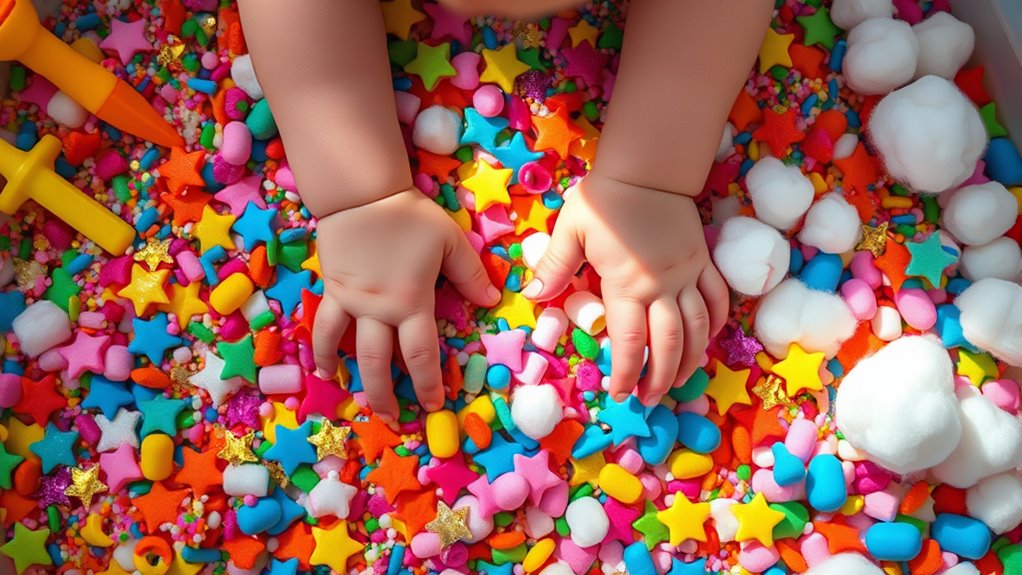
Sensory bins filled with wonders offer a mesmerizing way to engage your toddler’s senses and promote exploration. By combining artificial textures like soft beads, rough stones, and smooth shells, you create a rich tactile experience. Incorporate scent exploration by adding fragrant herbs or spices, enhancing sensory engagement. These bins stimulate curiosity while developing fine motor skills and sensory processing. To maximize benefits, customize your bin with different themes and materials.
| Texture Type | Artificial Textures | Scent Exploration |
|---|---|---|
| Soft | Fabric scraps, foam balls | Lavender, citrus |
| Rough | Sand, gravel | Cinnamon, mint |
| Smooth | Water beads, polished stones | Vanilla, peppermint |
| Fluffy | Cotton balls, shredded paper | Rose, eucalyptus |
DIY Mud Kitchen Creations
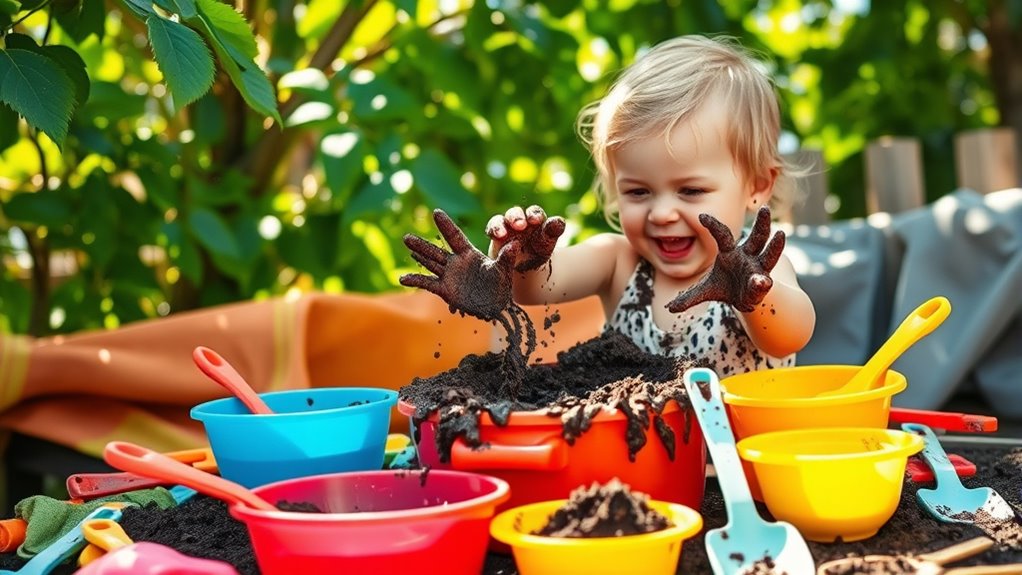
Creating a DIY mud kitchen is a fun way to bring nature-inspired materials into your child’s play. Use safe, reusable supplies to encourage endless experimentation and cleanup. Try setting up creative cooking challenges to spark their imagination and keep them engaged. Incorporating easy cleanup features can make the experience more enjoyable for both children and parents. Additionally, choosing preppy dog names inspired by fashion and culture can add a fun theme to outdoor play areas. Incorporating ideas from hackathons, such as collaborative problem-solving and innovative organization, can also inspire organizing your play space efficiently and scaling activities as your child’s interests grow. Emphasizing creative play can further enhance their developmental skills and make outdoor activities even more enriching.
Nature-Inspired Materials
Building a DIY mud kitchen with natural materials offers your toddler a fantastic way to explore nature while developing their creativity and sensory skills. You can encourage activities like leaf rubbing, where they press leaves onto paper to reveal textures, fostering fine motor development. Pine cone sorting allows them to classify different shapes and sizes, enhancing cognitive skills. Using items from nature creates a rich, tactile experience that sparks curiosity. Additionally, understanding the importance of color accuracy can help in selecting materials that create vibrant and engaging visual effects for your child’s art projects. Incorporating safety considerations ensures that all natural elements used are non-toxic and suitable for young children, making the experience both fun and secure. Exploring different natural textures can further stimulate their tactile senses and deepen their connection to the environment. Introducing guidance on age-appropriate tools can also help children safely participate in creative activities and build their confidence. Incorporating risk management strategies allows you to create a safe play area while encouraging exploration and independence.
Safe and Reusable Supplies
Using natural materials in your toddler’s play encourages exploration and creativity, but safety and sustainability are just as important. When creating a DIY mud kitchen, choose reusable supplies made from child-safe materials to guarantee safe, eco-friendly fun. Opt for sturdy, washable containers, spoons, and utensils that can withstand messes and be used repeatedly. Avoid items with sharp edges or small parts that could pose choking hazards. By selecting reusable supplies, you reduce waste and teach your little one about caring for their environment. Always check that all materials are non-toxic and free from harmful chemicals. Incorporating safe, sustainable items promotes both imaginative play and responsible habits, making mud kitchen adventures enjoyable and worry-free for you and your toddler. Performance cookies can help monitor how your child interacts with the play setup to improve future activities.
Creative Cooking Challenges
Engaging your toddler in creative cooking challenges with their DIY mud kitchen sparks imagination and encourages problem-solving. Offer simple, healthy snack options like fruit slices or veggie sticks to make the activity educational and nutritious. Keep safety in mind by supervising closely, especially when handling utensils or small items, and establish clear cooking safety tips, such as washing hands beforehand and avoiding hot surfaces. Use this opportunity to teach your child about different textures and flavors while fostering independence. Let them experiment with mixing ingredients or creating pretend recipes—this enhances their creativity and fine motor skills. Incorporate merchant services options like mobile payment solutions to easily manage snack purchases or activity fees during playdates. Remember, the goal is to have fun and explore, so keep the challenges light-hearted and adaptable to your child’s abilities. Encouraging creative thinking during these activities can also promote cognitive development and problem-solving skills from an early age. Additionally, introducing simple cooking tools and utensils can help your toddler develop fine motor skills and hand-eye coordination, making the experience both educational and entertaining. Exploring new concepts like angel numbers in a playful context can subtly introduce them to patterns and symbolic thinking, broadening their understanding of patterns and symbolism.
Bubble Wrap Stomp Art
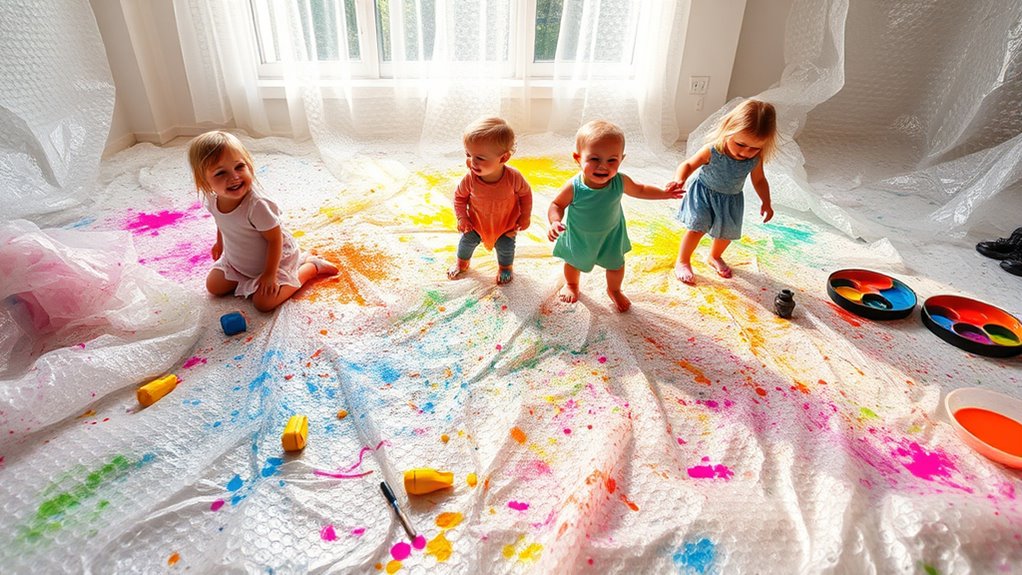
Stomping on bubble wrap is a fun, sensory-rich activity that toddlers love, and it’s easy to set up at home. As they stomp on the bubble wrap, they experience the satisfying bubble wrap pop, which provides instant auditory feedback. This activity offers excellent sensory stimulation, engaging their sense of touch, sound, and even sight as they watch the bubbles burst beneath their feet. To add a creative twist, you can tape the bubble wrap onto a large sheet of paper or cardboard and let your toddler use their feet to create colorful, textured artwork. It’s messy, playful, and perfect for encouraging movement and sensory exploration while giving them a satisfying burst of fun with every stomp. Incorporating sensory activities helps toddlers develop their fine and gross motor skills while making the experience enjoyable. Additionally, engaging in such activities can support emotional development by allowing children to express themselves freely in a playful environment. Using appropriate materials ensures safety and maximizes the sensory benefits of the activity. Incorporating knowledge about headphone types can also help you choose the best audio equipment if you want to include music or sounds to enhance the sensory experience. Furthermore, understanding website performance metrics can help you monitor how often your child engages in these activities and tailor them to their preferences.
Water Play With Toys and Tools
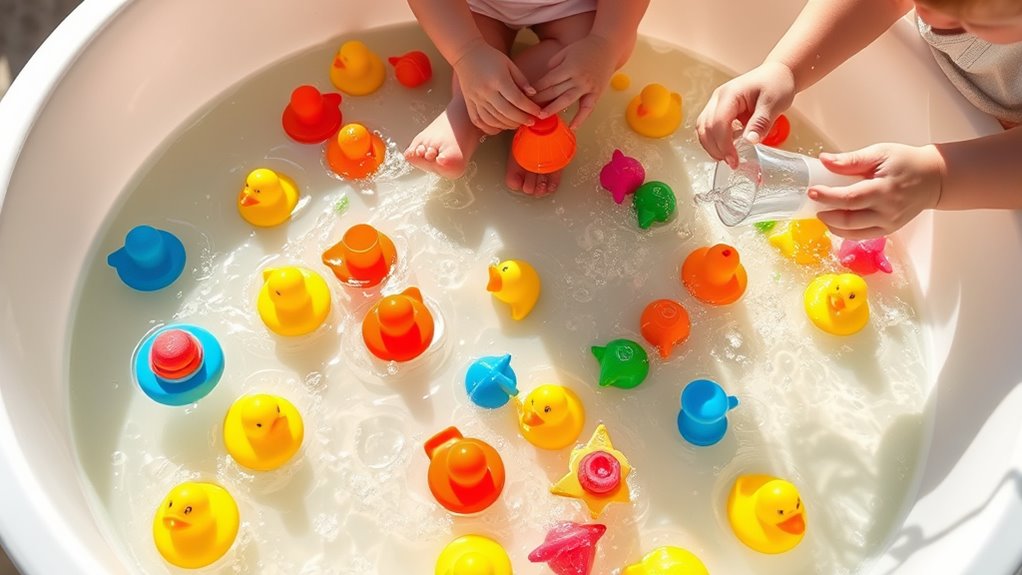
Choosing waterproof toys and tools guarantees safe, mess-free water play for your toddler. Using funnels and cups encourages exploration and fine motor skills. Always supervise wet play to keep it fun and safe.
Waterproof Toy Selection
Have you ever wondered how to keep water play safe and fun for your toddler? Choosing the right waterproof toys is key. Look for toys that have undergone durability testing to guarantee they can withstand rough handling and frequent water exposure. Moisture resistance is essential, so select items made from sealed, non-porous materials that won’t trap water or harbor mold. Rubber ducks, plastic boats, and waterproof rubber figures are ideal options because they’re designed to last through messy, splashy play. Avoid toys with small parts that could detach or absorb water over time, which could lead to mold or deterioration. By selecting durable, moisture-resistant toys, you ensure safe, enjoyable water play that lasts without constant replacement. Additionally, opting for eco-friendly options made from sustainable materials can help reduce environmental impact while maintaining durability and safety.
Using Funnels and Cups
Using funnels and cups is a simple way to make water play both fun and educational for your toddler. As they experiment with pouring, they develop precision pouring skills, improving their hand-eye coordination. Encourage them to transfer water between containers, watching how it flows and fills each cup. This activity also offers a chance for color mixing if you add drops of food coloring to the water, creating vibrant combinations that captivate their attention. Let your child explore pouring at different speeds, which enhances control and patience. With just a few tools, you can turn water play into an engaging learning experience that promotes fine motor skills, color recognition, and problem-solving—all while having fun together.
Supervised Wet Play
Supervised wet play with toys and tools transforms water time into a safe, engaging experience for your toddler. It’s an excellent way to combine dry land activities with indoor water experiments that stimulate curiosity and develop fine motor skills. As you supervise, introduce simple tools like scoops, sponges, and waterproof toys to make water play more interactive. You can set up small basins or tubs indoors, ensuring safety while exploring textures and movement. These activities encourage sensory exploration and can be easily adapted to your space and your child’s interests. Remember, always supervise closely to prevent spills or accidents. Wet play not only offers endless fun but also nurtures your toddler’s creativity and understanding of water, making it a valuable part of your messy play routine.
Nature Collage Making
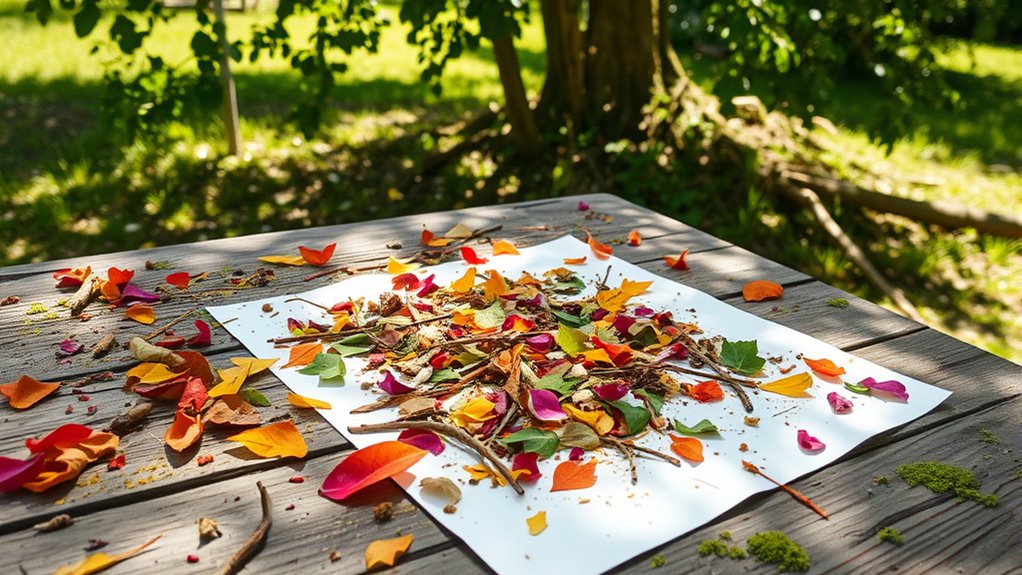
Creating a nature collage is a delightful way to encourage your toddler’s creativity while exploring the outdoors. Start with a botanical exploration, letting your child gather leaves, flowers, and small twigs. These natural materials add texture and color to the collage. Use simple supplies like glue and a sturdy piece of paper or cardboard as your base. Encourage your toddler to arrange and press the items onto the surface, fostering their artistic expression. You can also introduce leaf printing by applying a bit of paint to the underside of a leaf and pressing it onto the paper, creating beautiful patterns. This activity promotes sensory exploration, fine motor skills, and an appreciation for nature’s beauty, making it a fun, messy play experience your toddler will love.
Shaving Cream Cloud Dough
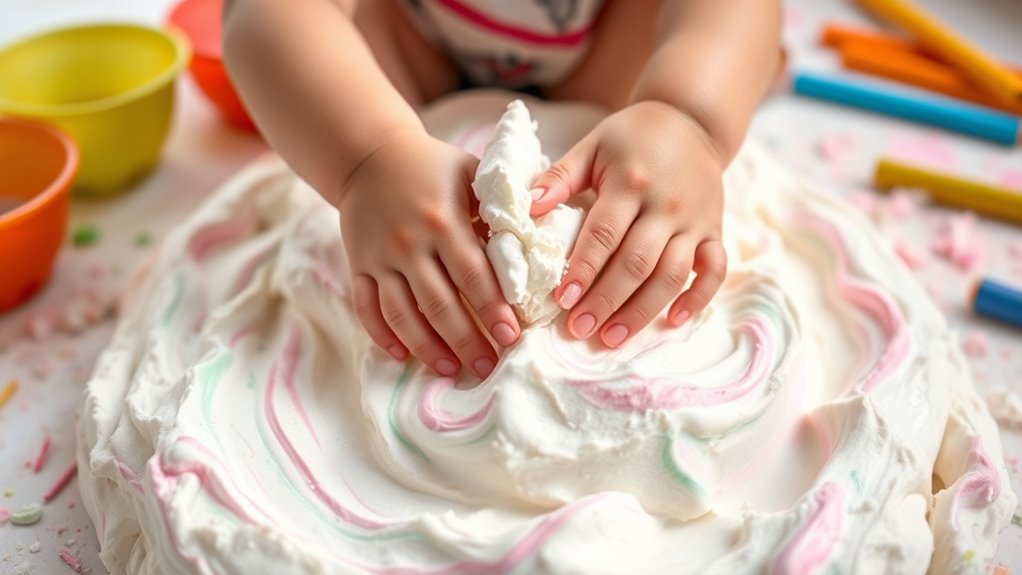
Building on the tactile fun of a nature collage, exploring shaving cream cloud dough offers your toddler a soft, squishy sensory experience. To keep it safe, always supervise your child during play and ensure they understand not to ingest large amounts. When making the dough, use non-toxic shaving cream and flour, and avoid any products with added fragrances or dyes. After playtime, store the cloud dough in an airtight container or resealable bag to keep it fresh and prevent messes. This simple storage solution makes cleanup easier and allows you to reuse the dough for multiple play sessions. Remember to wash your child’s hands afterward to maintain hygiene, and check the dough regularly for any changes in texture or smell, discarding it if it becomes moldy or overly sticky.
Frequently Asked Questions
How Can I Ensure My Toddler Stays Safe During Messy Play?
To keep your toddler safe during messy play, you should child proofing hazards like sharp objects, choking risks, and slippery surfaces. Always supervise closely using active supervising techniques—stay nearby, watch their movements, and intervene if needed. Use non-toxic, washable materials and create a designated, easy-to-clean play area. This approach guarantees your little one can enjoy messy fun while minimizing risks and maintaining safety.
What Are Some Quick Cleanup Tips After Messy Activities?
Think of cleanup as tending a garden after a storm—you need quick, effective tools to restore order. Use designated toy storage to swiftly gather supplies, and stick to simple cleaning routines like wiping surfaces and soaking fabrics. Keep cleaning supplies handy for fast action. This way, you tame the chaos, making cleanup feel less like a chore and more like restoring harmony, so your home stays cheerful and tidy after your toddler’s messy adventures.
How Can I Adapt Messy Play for Limited Space or Indoors?
You can adapt messy play for limited space by choosing indoor sensory activities that are compact and contained. Use a small tray or a plastic bin to keep the mess confined, and set up a designated area for play. Consider activities like finger painting, rice bins, or slime, which work well indoors. Always supervise closely, and use washable materials to make cleanup easier, ensuring your toddler enjoys creative fun without the clutter.
What Materials Are Safest and Most Non-Toxic for Toddlers?
When choosing materials, you want to prioritize safety for your toddler. Use non-toxic paints and confirm all supplies are BPA-free to minimize exposure to harmful chemicals. Look for labels that specify these features, and avoid anything with strong fumes or sharp edges. Always supervise play and test materials on a small skin area first. Your goal is to create a fun, safe environment that encourages creativity without compromising health.
How Do I Encourage Sharing and Social Skills During Messy Play?
Oh, sure, because sharing’s just natural, right? To encourage sharing and social skill development during messy play, use sharing strategies like setting timers or taking turns. Praise your toddler when they share or help others. Create opportunities for teamwork, like group projects. These simple steps turn messy play into a social skill-building party, helping your little one learn cooperation, patience, and empathy amidst the colorful chaos.
Conclusion
Think of these messy play ideas as a colorful garden, each activity a vibrant flower blooming with creativity. Embrace the chaos, knowing it helps your toddler grow in confidence and imagination. With every splash, smear, and stomp, you’re painting a masterpiece of development and joy. So, plunge into the mess—it’s the most beautiful chaos that nurtures your child’s curiosity and sparks endless fun. Let the messy adventures begin!

